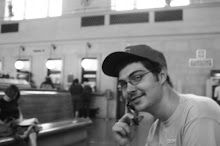I just got back from my afternoon scooter ride with Piyush. Let me say that he must be one of the fastest drivers that the Ahmedabad roads have seen. Himanshu promised that the ride would be perfection, and it was close. It would have been perfect if it were not for a little accident we had with another scooter. The man yelled in hindi that Piyush couldn't drive, and this happening in the first ten minutes of the afternoon made me beleive him.
Still there is nothing like weaving in and out of cars, bikes, children and rickshaws at 60 km/hr. And when we were crossing a bridge in Ahmedabad over the river, I could not help but stretch my arms out and look up. Being unrestrained and squashed behind a small indian man driving way over the speed limit in the enveloping sunshine was one of the most freeing and enjoyable things I have done in a long time. And to top it all off, Piyush sang beautiful hindi songs under his breath as we rode; it was the perfect private soundtrack to the visual and emotional colorwheel that was my afternoon.
Our first stop was a caravan center. Caravan centers are classrooms in poor neighborhoods that provide the area with vocational and english classes, along with personal finance advice. The room, while dim and grimy, is still an incredibly valuable service to the community, and all are thankful. I cannot help but think of the American school system, where there is so much more offered, but so few students care to learn. All the children want here is a chance. Its as Himanshu said when I asked him what he does after programming at work. He said, "programming." Everyone is just trying to do a little better.
One of the most eye opening moments of the caravan center visit was when the manager, translated by Piyush, explained to me the history of the building. Painted white with blue shutters, window frames, and tile floors, it was easily one of the nicest structures in the area. Apparently it was a housing facility for those affected by leprosy only ten years ago. Reassured that there were no traces of it or lepers around (my ears shot up when I heard hindi hindi hindi leprosy here hindi hindi), it was explained that this was why SPRAT was able to afford the nicest building in the area. On the way out, the man joked that he could take me to a certain area and show me leprosy. I am still warming up to Indians' sense of humor.
Our next stop was a proposed site for another Muskaan (adventure) park. This consisted of an abandoned lot scattered with garbage, and a few goats looking for a morsel to eat. Since SPRAT has little money, I asked how they acquired the lot for free.
Piyush pointed over a brick wall at the ajacent lot. The odd smell I had noticed was eminating from a tall smokestack, and my vision was filled with the machinery and the image of a large, towering chemical factory. Surely having such an industrial polluter next to a childrens park cannot be a good idea. After inquiring about the health ramifications, I realized it was pointless. Free land was free land, and pollution is present all around the city, so why not at such close proximity? I do not agree with this logic, but it seems that I can do little to steer the NGO away from this.
Our last stop was the existing Muskaan park. What an incredible place. There are huge play structures, climbing walls, and ziplines for the neighborhood kids to play with, and all of it is made with recycled materials. All the free space around the city is dirty and filled with trash, except for this space. Upon arriving here, I understood the importance of creating play parks for kids. This way, kids can run and play and see green grass. They can play cricket without getting run over by a car or bike. And the kids love it!
Subscribe to:
Post Comments (Atom)

1 comment:
Dude, your stories/tails are crazy. No one moves that fast in Craig. I got tired just reading it.
Post a Comment